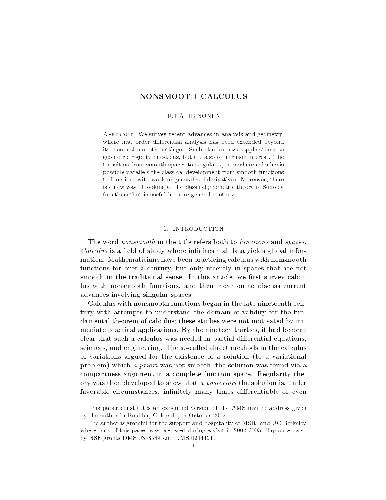Nonsmooth calculus
3.0
Reviews from our users

You Can Ask your questions from this book's AI after Login
Each download or ask from book AI costs 2 points. To earn more free points, please visit the Points Guide Page and complete some valuable actions.Introduction to Nonsmooth Calculus
In the world of mathematics, calculus has long been synonymous with smoothness and continuity—a realm governed by concepts like derivatives, gradients, and smooth curves. But what happens when these assumptions break down? What if the terrain you're navigating is rugged, irregular, and nonsmooth? This is the domain of Nonsmooth Calculus, a nuanced and intricate mathematical framework that extends classical calculus into more challenging territories. This book dives deep into the heart of nonsmooth analysis, exploring its theoretical underpinnings while shedding light on its vast applications in optimization, control theory, and beyond.
Written with precision and clarity, Nonsmooth Calculus is designed for mathematicians, researchers, and practitioners who grapple with irregular structures and discontinuities in their work. Whether you're a student encountering nonsmooth concepts for the first time or an experienced scholar looking for rigorous insights, this text serves as both a foundational introduction and an advanced guide. Let us walk you through a detailed summary, key takeaways, memorable quotes, and the importance of this book in contemporary mathematics.
Summary of the Book
At its core, Nonsmooth Calculus focuses on extending classical calculus into settings where traditional methods fail. This is typically the case in scenarios where smoothness is not guaranteed—when functions are not differentiable in the classical sense, or when optimization problems involve constraints that lead to nonsmooth solutions. The book systematically introduces the reader to concepts such as subgradients, set-valued maps, and the Clarke derivative, along with a suite of tools designed explicitly for nonsmooth contexts.
The book is structured to transition the reader from the basics of calculus into its nonsmooth extensions. It begins by revisiting classical differential calculus, establishing the limitations of traditional approaches in nonsmooth settings. Following this, it delves into nonsmooth differential operators, their definitions, and their properties, emphasizing how these concepts generalize classical ideas. Later chapters connect these theoretical foundations to real-world problems, providing examples and applications in optimization and control theory. The book’s consistent focus on rigor and clarity ensures readers can grasp the nuances of nonsmooth analysis while appreciating its power and versatility.
Key Takeaways
- A detailed introduction to subgradients, Clarke derivatives, and other nonsmooth calculus concepts.
- An exploration of how nonsmooth calculus generalizes classical differential calculus.
- Applications of nonsmooth analysis in optimization, control theory, and variational inequalities.
- Practical tools and methods for solving nonsmooth problems in mathematical and engineering contexts.
- A balance between rigorous mathematical theory and practical examples.
Famous Quotes from the Book
“Smoothness is a luxury; real-world problems rarely grant such ease.”
“Calculus, at its heart, is about change—but change is often nonsmooth, unpredictable, and complex. Nonsmooth calculus confronts this reality head-on.”
“The power of nonsmooth analysis lies not in simplifying the world, but in providing tools to navigate its inherent irregularities.”
Why This Book Matters
The importance of Nonsmooth Calculus lies in its relevance to both theory and practice. Classical calculus, while elegant and powerful, is limited in its ability to address the nonsmooth problems encountered in optimization, control theory, and data analysis. By equipping readers with the tools of nonsmooth calculus, this book bridges the gap between the mathematical ideal of smoothness and the gritty realities of irregular systems.
In addition, nonsmooth calculus has profound implications for interdisciplinary fields. Engineers designing controllers for systems with abrupt changes, economists modeling irregular markets, and computer scientists optimizing machine learning algorithms all benefit from the concepts presented in this text. By formalizing and extending nonsmooth analysis, this book enriches both the mathematical toolkit and its utility in the applied sciences.
Ultimately, Nonsmooth Calculus matters because it challenges conventions and expands horizons. It invites the reader to rethink calculus itself, questioning assumptions and embracing complexity. For anyone grappling with irregularity—whether in mathematics, science, or engineering—this book offers indispensable insights and guidance.
Free Direct Download
You Can Download this book after Login
Accessing books through legal platforms and public libraries not only supports the rights of authors and publishers but also contributes to the sustainability of reading culture. Before downloading, please take a moment to consider these options.
Find this book on other platforms:
WorldCat helps you find books in libraries worldwide.
See ratings, reviews, and discussions on Goodreads.
Find and buy rare or used books on AbeBooks.
1143
بازدید3.0
امتیاز50
نظر98%
رضایتReviews:
3.0
Based on 0 users review
"کیفیت چاپ عالی بود، خیلی راضیام"
Questions & Answers
Ask questions about this book or help others by answering
No questions yet. Be the first to ask!


